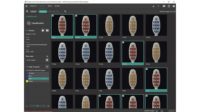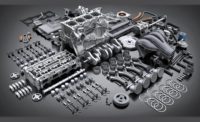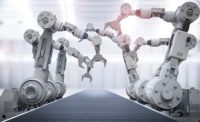A sub-discipline of artificial intelligence (AI), deep learning (DL) has become a breakout technology in high-profile market sectors such as retail and high-tech. Manufacturing has been slow to follow, though, and that’s a situation ripe for change. Operational success in manufacturing hinges on maximizing throughput while ensuring product quality. Here, DL can play a key role.
For years, machine vision has been the go-to tool for optimizing process performance by removing human error from inspection and identification. While traditional vision systems can be extremely effective for suitable applications, in more complex circumstances, their capabilities fall short. Today, DL-based inspection systems can augment and enhance existing machine vision systems, representing yet another tool in the toolbox of the modern-day manufacturer.
Vision & Sensors
A Quality Special Section
1. Shift The Data Paradigm
Properly integrated, a DL-based automated inspection system can increase manufacturing efficiency, improve productivity, and, ultimately, drive revenues. The benefits don’t stop there, however. The DL development process can lead to a scalable, organization-wide consensus on what constitutes a defect and how product quality should be defined. The tight coordination among the shop floor, IT, and the top floor that is part and parcel of a DL project can lead to more consistent practices across shifts, production lines, and facilities. Finally, the production system generates a rich trove of data that can be used for statistical feedback to support objectives such as process control and even predictive maintenance.
Of course, with DL, as with so many other technologies, the devil is in the details. Realizing the benefits above starts with understanding the role DL plays in the manufacturing environment and recognizing which pain points are best resolved using DL. Finally, and perhaps most important, the entire process, from training through production deployment, must be based on high-quality and accurately tagged input data.
2. Find A Deep Learning Sweet Spot
Conventional machine vision software leverages rules-based algorithms — they make decisions based on mathematical definitions of what constitutes a good part versus a bad part. Rules-based systems can be extremely effective under controlled conditions: repeatable processes, uniform products, and consistent environments. Checking the labels of bottles on a bottling line, for example, would be a good use case. The bottles are uniform and presented in a consistent orientation, with labels applied in the same position. If a label is tilted, too high, too low, or absent, the system can easily identify it as a flawed product.
Problems arise with rules-based machine vision when the process is not controlled. If the factory has a lot of south-facing windows and the labels are metallic, for example, image quality may suffer from reflections created by the afternoon sunlight. Product variation can be another problem. Inspecting oranges can be a good problem for a rules-based engine because oranges are very consistent in appearance: spherical, orange in color, and about the same size. If a grapefruit appears on the conveyor belt, the system will quickly identify it as abnormal. To machine vision, the shape of a pear, however, depends on its orientation. Even when pears are presented in the same orientation, the proportions can vary substantially. Lines that switch out products frequently can also be problematic since rules-based engines can take a significant amount of time to tune for optimal results at production speed.
The conditions in which rules-based inspection fall short are precisely where DL shines. It doesn’t require an algorithm to define rules. Instead, the DL algorithm learns by example. Over many examples, the algorithm can learn a multitude of details that identify a pear. It can recognize the fruit, no matter the orientation or normal variation. Still, we are talking about abstract benefits. Success still lies in the execution.
3. Data-Driven Success
There’s a broad understanding that technologies such as DL require large amounts of data. Data in and of itself isn’t enough, however. Inconsistently labeled or confusingly presented data will result in an ineffective model. This particularly holds for DL applications, which are ideally being trained to operate with a significant degree of autonomy. Achieving success on the shop floor, in IT, and in the C-suite requires taking a data-centric approach to DL development.
The traditional model-centric approach focuses on tweaking the code to help the algorithm make sense of any substandard data. This method might eventually lead to a model that can perform well on the test data sets but not necessarily on production data. It adds to the time and cost of development because data sets with subpar images, tagging, and organization can send development time and cost soaring. A model given a training set with just 10% of the data mislabeled requires 1.88 times as much data to reach the target accuracy. Raise that proportion of mislabeled data to 30%, and the model requires a training set 8.4 times as large to reach the target.
Numbers like these give new meaning to the phrase “work smarter, not harder.” The trick is to avoid the model-centric approach and instead take a data-centric approach. Don’t tweak the model to work with substandard data. Instead, use quality data, and the model will train itself. This data-centric approach of quality over quantity is the most efficient path to a production-ready system.
Having human experts assemble quality data sets can seem challenging upfront. Test sets may include images with poor contrast or focus. Experienced labelers may disagree on what constitutes a defect. Even the organization of the data set can cause confusion in the model. And it’s a big job, which can sometimes cause eager teams to rush and make mistakes.
Fortunately, modern DL solutions can streamline the effort. Instead of expecting developers to work miracles with models and substandard data, companies can use an end-to-end DL solution to rapidly assemble high-quality data sets. The software includes tools designed to speed defect identification and tagging using a centralized platform that encompasses data management, models, and deployments. Everything is built with collaboration and transparency in mind so that inspectors and operators company wide can work together to build a “defect book” that standardizes product quality. These tools help minimize the time spent on code and model development and shorten the time to production deployment. Companies don’t have to be DL experts; they just need to be experts when it comes to their products.
4. Can Deep Learning Help Manufacturers?
The general answer to the question of whether DL can help your manufacturing operation comes down to execution. The process begins with identifying an appropriate problem. Just because DL can perform a task doesn’t mean that it should. Look for identification or inspection systems that are delivering a significant number of false positives or false negatives or that fault out frequently. Are the conditions variable and unsuitable for a rules-based system? That’s a great target of opportunity for DL.
Vision & Sensors
A Quality Special Section
Next, consider data. You will need to follow a data-centric approach. That requires gathering high-quality, expertly tagged images for the training set. You may have to upgrade or tune your vision systems to ensure quality images. Be prepared to prune data sets to get only quality input and organize escalating defects in a logical order.
Finally, establish a framework to take advantage of the expertise of operators and quality inspectors. Tagging data for training sets is essential, but it’s just the start. Even after the system is deployed in a production environment, “human-in-the-loop” techniques help improve performance of the AI system and increase the confidence of staff in the software. It starts with the DL system making decisions in parallel with human inspectors to check accuracy and identify any failures so they can be used to train the model. Next, the DL system makes decisions while a human inspector confirms accuracy, once again leveraging any errors to provide the operation. Finally, the software takes over the routine decisions, letting humans resolve ambiguous cases but also using those instances to further improve performance.
If all these pieces are in place, then DL can absolutely bring value to your manufacturing operations.
Conclusion
In an era of labor shortages, tight production margins, and even tighter budgets, manufacturers seek to further broaden their use of automation. DL technology can provide manufacturers one platform to handle all automated inspection applications. Modern DL vision platforms automate much of the development process, leaving users to focus on defining defects. Ready to give it a try? Start with a single pilot project that targets the sweet spot for DL. Remember the human factors: make sure you engage the shop floor as well as developers and IT. Most of all, make a commitment to data. A data-centric approach will deliver better results and a more resilient system in the shortest time and with the lowest investment. Can DL improve your manufacturing operation? You bet.



